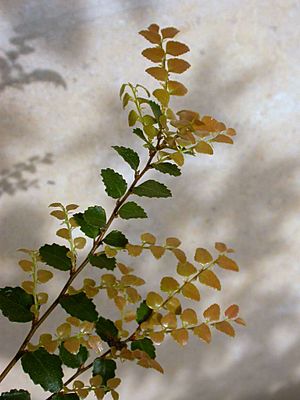Myrtle beech facts for kids
Quick facts for kids Myrtle beech |
|
|---|---|
 |
|
| Foliage with young growth | |
| Conservation status | |
| Scientific classification | |
| Genus: |
Nothofagus
|
| Species: |
cunninghamii
|
| Synonyms | |
|
Lophozonia cunninghamii |
|
The myrtle beech, also known as Nothofagus cunninghamii, is a special type of tree. It's an evergreen tree, which means it keeps its leaves all year round, just like some Christmas trees! You can find it growing naturally in Tasmania and Victoria, Australia.
This tree loves to grow in cool, wet places called temperate rainforests. But it can also survive in colder, high-up areas like mountains (alpine areas). Even though it's called "myrtle beech," it's not actually part of the Myrtle family of plants. Sometimes, people who work with wood call it the Tasmanian myrtle.
Scientists sometimes change the names of plants. In 2013, some thought the myrtle beech should be called Lophozonia cunninghamii. There was a bit of a discussion about this name change.
Myrtle beech trees can be quite different in size. Some grow into huge trees, reaching 30–40 m (98–131 ft) tall with thick trunks. Others, especially in cold mountain areas, stay small, like shrubs less than 1 m tall. The tallest ones can grow up to 55 m (180 ft)!
Their leaves are small, usually 0.5–1.5 cm (0.2–0.6 in) long. In Victoria, they can be a bit longer, up to 2 cm (0.8 in). They are dark green, but when new leaves grow in spring, they can be bright red, pink, or orange. The leaves are shaped like tiny triangles with small, jagged edges.
Myrtle beech trees have both male and female flowers on the same tree. These flowers are tiny and hard to see. They grow in small groups near the tips of the branches. The fruit is also small, about 6 mm (0.24 in), and woody. Inside, it holds three small nuts with little wings.
Sometimes, you might see strange, round, orange things growing out of the tree's trunk. These are actually a type of fungus called Cyttaria gunnii.
Contents
Uses of Myrtle Beech Wood
Myrtle beech wood is very popular for making furniture and other items. It's a strong wood with a tight grain, which means it's very durable. The wood is usually a soft pink to reddish-brown color. It often has beautiful patterns and can be polished to a lovely shine.
People use this wood for many things, like:
- Flooring in houses
- Making parts for doors and windows (joinery)
- Gears for machines
- Furniture
It's also good for bending with steam, turning on a lathe, and carving. Much of this wood comes from very old forests. However, a lot of the myrtle beech wood is left on the ground after other trees, like the huge mountain ash, are harvested. The dry wood weighs about 700 kg/m3.
Where Myrtle Beech Grows and How to Grow It
Myrtle beech trees need a good amount of rain, about 900 mm (35 in) spread throughout the year. They are most common in Tasmania, where they grow in most areas except the very dry parts. You can also find some large groups of them in Victoria.
These trees grow best in rich, red mountain soils or in soils with lots of plant material. They can grow in full shade, but they will grow slowly. If they get enough water, they can also grow in full sun.
It's quite easy to grow myrtle beech from fresh seeds. The seeds usually sprout in just a few weeks. You can also try to grow them from cuttings, but plants grown from seeds often do better.
Myrtle beech trees can handle different temperatures. They can survive hot days of 45 °C (113 °F) and cold nights down to −7 °C (19 °F). Trees growing in the mountains can even survive colder temperatures, at least down to −15 °C (5 °F).
You can see examples of myrtle beech trees at The Tasmanian Arboretum. Both the myrtle beech and a related tree called the Antarctic beech are great places for other plants, called epiphytes, to grow on them. Epiphytes are plants that grow on other plants, but they don't harm them.
Threats to Myrtle Beech Trees
Myrtle beech trees face a few dangers. One big threat is a disease called myrtle wilt. This disease is caused by a parasitic fungus. A parasitic fungus is like a tiny plant that lives on another plant and takes its food. The fungus spores float in the air and can infect the myrtle beech if they land on an open wound on the tree.
Myrtle wilt is a natural disease, but it has become a bigger problem recently. This is partly because of some logging practices that create more open wounds on the trees.
Another threat is strong fires. Myrtle beech forests cannot survive very hot fires. If a strong fire happens, the trees must regrow from seeds that come from nearby areas that weren't burned. However, they can survive lighter fires. After a light fire, they can regrow from seeds or sometimes from special shoots that grow from the base of the tree.
Generally, myrtle beech forests take a very long time to grow. They usually only form after a wet sclerophyll forest (a type of forest with hard-leaved trees) has grown old and mature, which can take hundreds of years.
Images for kids
See also
 In Spanish: Haya mirto para niños
In Spanish: Haya mirto para niños






